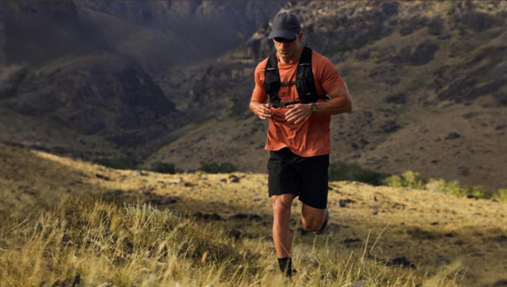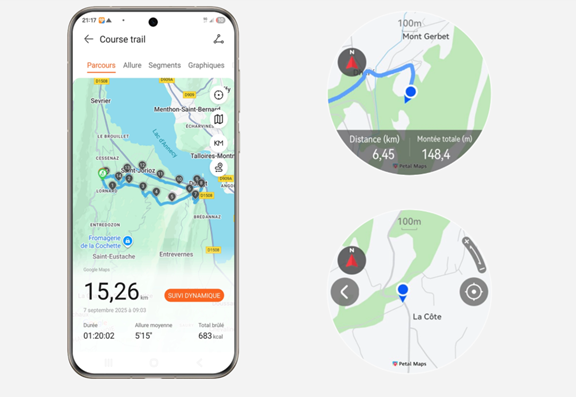Trail running tests your endurance and navigation abilities; therefore, a GPS wristwatch is a vital tool. These watches provide precise monitoring, route direction, and performance analytics to help you remain on target and monitor your progress. The ideal model strikes a compromise between tough durability, extended battery life, and smart data capabilities designed specifically for off-road use. Whether you're preparing for an ultramarathon or exploring weekend trails, selecting a watch that suits your terrain and fitness objectives will improve your experience. This tutorial discusses which features are most important and how to tailor a GPS watch to your own running style for smarter, safer, and more effective runs.

What Features Matter Most in a Trail-Running GPS Watch?
Accurate GPS and Multi-Band Tracking
GPS accuracy is essential while jogging through forests, valleys, or high-altitude paths. Look for smartwatches that use multi-band GNSS technology, which links to various satellite systems like GPS, GLONASS, and Galileo. This dual-frequency capability allows for accurate position tracking even in locations with poor signals or interference, such as extensive forest cover or rough terrain. Real-time breadcrumb trails and distance correction decrease route diversion while increasing safety. When traversing unexpected paths, fast satellite lock-on and quick route adjustment are vital. For those learning how to start running on trails, this level of accuracy provides guidance and reassurance. An accurate GPS watch not only helps you stay oriented but also ensures reliable data for pace, distance, and elevation. For trail runners, this accuracy builds confidence and supports consistent performance tracking over challenging terrain.
Durable Build and Water Resistance
Trail runners require clothing that can withstand tough weather. A reliable GPS watch should withstand stress, dirt, dust, and water without sacrificing functionality. Select models that include scratch-resistant sapphire glass, reinforced polymer or titanium bezels, and military-grade durability certifications. Water resistance of 5ATM or more protects against rain, perspiration, and the occasional stream crossing. Responsive buttons and glare-resistant displays improve usage in bright light or damp conditions. Rugged materials and sealed components protect internal components from impact and moisture. Many versions have glove-compatible designs for alpine or cold-weather runs. When your journey takes you through unknown situations, a watch's physical durability is just as crucial as its software functionality and tracking precision.

Battery Life for Long Trail Sessions
Long-distance trail runs necessitate a smartwatch that will not fail mid-run. Look for devices that provide 20 to 40 hours of continuous GPS tracking, with extended modes lasting 60 hours or more. Some watches have adaptive battery management, which allows you to turn off non-essential features like heart rate tracking or smartphone alerts to save power. Solar-charging variations can replenish energy during daylight exposure, making them excellent for multi-day trips. Quick-charge alternatives are useful for a last-minute boost before a run. Smart battery profiles let you alter settings mid-activity, dependent on trail conditions. Reliable battery life means that your device records the whole session and gives precise post-run data for analysis and performance enhancement.
How Do You Match a GPS Watch to Your Training Style?
Pace, Elevation, and Heart-Rate Tracking Needs
Understanding your training objectives can help you narrow down your smartwatch alternatives. If you concentrate on speed and splits, emphasize real-time indicators such as cadence, pace alerts, and interval monitoring. A barometric altimeter allows mountain or hill runners to calculate elevation gain and loss accurately. Heart-rate data, collected by wrist sensors or coupled chest straps, is useful for monitoring exertion and recovery zones, particularly on steep climbs. Watches that provide advanced metrics like VO2 max, training load, and recovery time provide a better understanding of endurance improvement. The correct feature set keeps you informed of your efforts and progress, making each run more efficient. By combining the watch's data capabilities with your individual training goals, you can convert raw data into relevant feedback for your next session.
Navigation Tools Like Maps and Route Guidance
Navigating new routes requires the use of navigation tools. Look for smartwatches that provide turn-by-turn directions, breadcrumb tracking, and offline topo maps. You may safely track platform routes without phone service thanks to this technology. Watches are safer because of waypoint labeling, digital compasses, and back-to-start routing. Certain models alert users to severe bends or forks or show upcoming elevation profiles. Wearing a wrist-mounted route visualization reduces the need for paper and phone maps. These characteristics support training for ultramarathons or alone. When exploring new terrain or staying on course in remote locations, having the right navigational aids increases safety and freedom.
Smart Features vs. Performance Features
Choose whether you want a watch that focuses on performance monitoring or one that combines lifestyle features. Power output, real-time elevation gain, enhanced heart-rate zones, and adjustable training modes are among the indicators that performance-focused watches highlight. They may exclude smart features to save battery life and streamline the UI. Smart features, on the other hand, include music streaming, SMS notifications, voice assistants, and wireless payments. These are useful for mixed-use runners, but they may reduce battery life and detract from training. Trail purists prefer minimalist UI and lightweight constructions, but tech-savvy consumers value an all-in-one connection. Consider your daily routine and how much overlap you anticipate between trail use and everyday wear. Balancing features with purpose ensures that your watch matches your specific demands.
Conclusion
A GPS wristwatch designed specifically for trail running is more than simply a tracker; it is a companion in performance, safety, and progress. Accurate location tracking, durable build, and long battery life are the foundations of a dependable trail-ready gadget. Matching the watch's functions to your own training goals, such as heart rate monitoring, navigation, or sophisticated analytics, guarantees that you get the most out of your investment. Smart decisions begin with understanding how and where you run. With the correct GPS wristwatch on your wrist, you'll be able to tackle more difficult terrain, run smarter routes, and train with purpose, knowing that your data supports every decision you make along the way.





